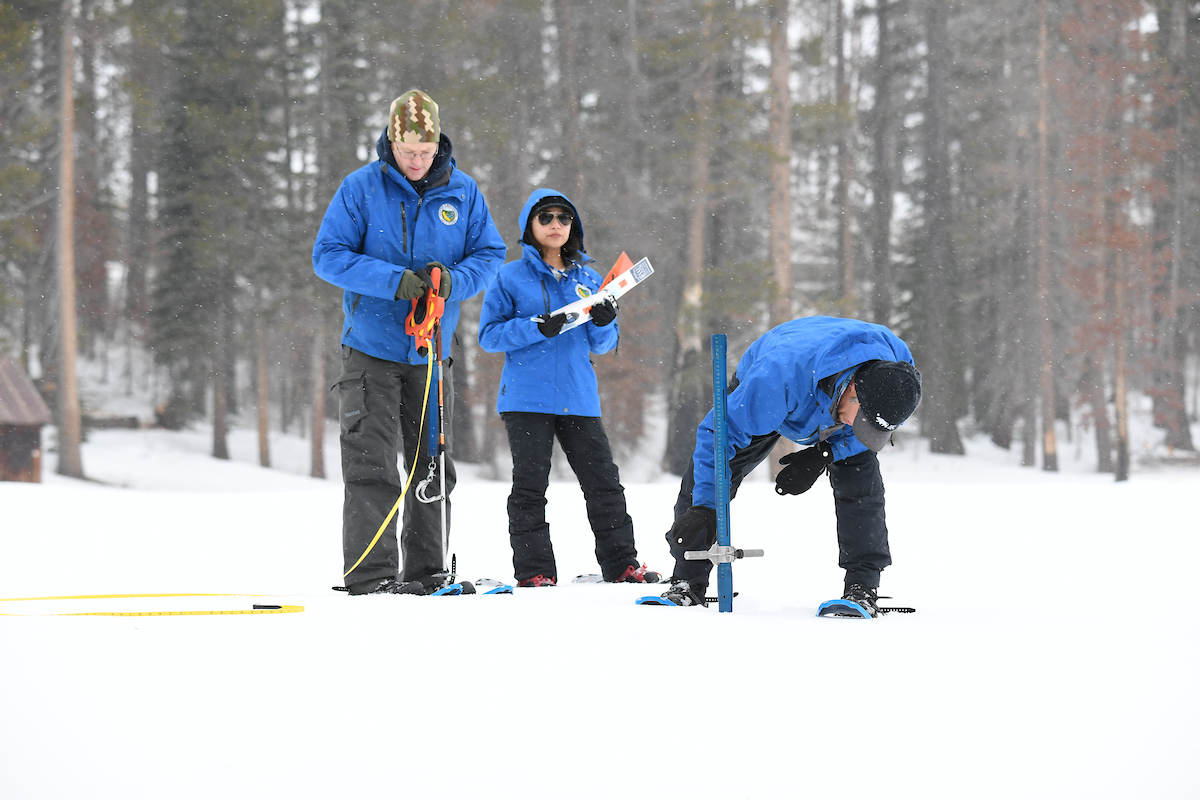DWR staff conduct the third snow survey of the season at Phillips Station on Feb. 29, 2024.
As California enters the last month of the traditional snow season, snowpack is near average in most regions
SACRAMENTO, Calif. – The Department of Water Resources (DWR) today conducted the third snow survey of the season at Phillips Station. The manual survey recorded 47.5 inches of snow depth and a snow water equivalent of 18 inches, which is 77 percent of average for this location. The snow water equivalent measures the amount of water contained in the snowpack and is a key component of DWR’s water supply forecast.
Today’s results reflect continued improvement in the snowpack since the slow and dry start to the water year. DWR’s electronic readings from 130 stations placed throughout the state indicate that the statewide snowpack’s snow water equivalent is 18.7 inches, or 80 percent of average for this date, an improvement from just 28% of average on January 1. The snowpack is currently only 70 percent of the critical April 1 average, when the snowpack is typically at its peak. An incoming storm is expected to bring several feet of snow to the Sierra Nevada this weekend.
“We are now in the last month of the traditional snow season and while conditions have dramatically improved since the beginning of the year, March will be critical in determining if we finish above or below average,” said DWR Director Karla Nemeth. “No matter how the season ends, we are ready to take advantage of the water we do have to benefit communities, agriculture, and the environment, and continue storing stormwater in our groundwater basins for future use.”
While California saw a number of storms in January and February that caused flooding in many areas of the state, the storms were warmer than average, dropping more precipitation as rain rather than snow, especially in Southern California. Overall statewide precipitation is 103 percent of average for this date, running well ahead of the snowpack. While surface water storage in California’s major reservoirs is currently 119 percent above average and the state continues to benefit from efforts to capture and store as much water as possible, the latest forecasts from DWR project snow runoff could be below average this spring due to the unusually dry start to the water year. DWR recently increased projected allocations from the State Water Project, and the forecasted allocation is expected to be revised again next month based on recent storms.
“California has seen several extreme climate events so far this water year, including record rainfall in Southern California,” said Dr. Michael Anderson, State Climatologist with DWR. “While this pushed statewide precipitation above average, the snowpack still has not caught up from the dry conditions earlier this winter and local conditions still vary significantly from region to region. The upcoming storm will deliver more snow, but the critical month of March will have to deliver enough snowpack to make up for the dry fall and slow start to the year.”
On average, the Sierra snowpack supplies about 30 percent of California’s water needs. Its natural ability to store water is why the Sierra snowpack is often referred to as California's “frozen reservoir.” Data from these snow surveys and forecasts produced by DWR’s Snow Surveys and Water Supply Forecasting Unit are important factors in determining how DWR manages the state’s water resources.
DWR conducts five snow surveys at Phillips Station each winter near the first of each month, January through April and, if necessary, May. The next and possibly final survey is tentatively scheduled for April 2.
For California’s current hydrological conditions, visit https://cww.water.ca.gov
For more information on finding your flood risk, visit https://myhazards.caloes.ca.gov/
For information on obtaining flood insurance, visit https://www.floodsmart.gov/
For information on how you can prepare your household for flood emergencies, visit https://www.ready.gov/kit
Additional Resources
- Video of today’s Phillips survey
- Digital photos of today’s Phillips survey
- B-roll of today’s Phillips survey
- Snowpack readings (View readings for current regional snowpack and historical snowpack comparison)
- Precipitation data (View current California Data Exchange Center charts for the Northern Sierra 8-station index for updated rainfall readings in the critical northern portion of the state, as well as the San Joaquin 5-station index and Tulare Basin 6-station index)
###
Jason Ince, Information Officer, Public Affairs, Department of Water Resources
(916) 820-8138 | Media@water.ca.gov
